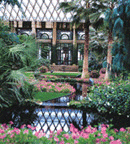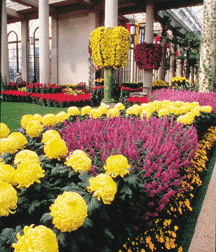VISIT LONGWOOD GARDENS ON THE WEB

The facts are staggering. Here you will find the greatest and the most in nearly every conceivable category: 1,050 acres of gardens containing exquisite flowers and majestic trees, twenty different outdoor gardens, twenty indoor gardens in four acres of heated greenhouses, and a total of 11,000 different species of plants, making this one of the greatest conservatories in the world. In addition to the plants, there are dazzling fountains, with variable multi-colored illumination, musical accompaniment, and a backdrop of fireworks on selected summer evenings, a spectacle that leaves the attendees spellbound. Then there are the over eight hundred horticultural and performing arts events ranging from flower shows, horticultural classes, and children’s programs to concerts, organ recitals, and musical plays. Finally, there is the impressive tally of over 900,000 people entering the gates each year.
Reducing this world of variety to its least common denominator, we find that all of this is the dream of one man, Pierre Samuel du Pont (1870-1954). In a country where the majority rules, one man put together a garden that has enchanted a people for decades. Only in America!
Pierre was the great-grandson of Eleuthère Irénée du Pont (1771-1834), a royalist who left France in 1800 and founded the family fortune by manufacturing gunpowder. Pierre later turned the family business into a chemical corporate empire. Using his fortune and his leisure, Pierre developed what was to become Longwood Gardens. The inspiration for Longwood came from his numerous trips to Europe, where he visited some two dozen villas and fifty chateaux. He even visited the garden of Claude Oscar Monet, hosted by the painter himself.
He threw himself into his projects with an unbounded energy. At 21 years of age he oversaw the construction of the new family homestead. By the time he was 28, he possessed his own commercial nursery with seven greenhouses. At 34, disappointed by professional landscapers, he drafted his own plans for improving the family’s estate. He began work on what is known today as Longwood Gardens at the age of 36, beginning with the 600-foot long Flower Garden Walk in 1907 and continuing to build as the “mood touched him.” At his urging, the Longwood Foundation was established in 1946, entrusted to operate the gardens “for the sole use of the public for purposes of exhibition, instruction, education and enjoyment.”
While visiting Longwood, I spoke with Mr. Colvin Randall, its Public Relations Manager. One of the first things I asked was whether any descendants of Pierre were still involved in the foundation. “Du Ponts were involved in the beginning of this Foundation and are still involved in the running of Longwood” he said. “Two-thirds of the board of trustees is made up of family members, Mr. du Pont didn’t have any children, so they are mostly his great nephews and great nieces, and a few of them carry the name du Pont.”
“Do they have horticultural experience?” I asked. “They are well known and respected in botanical circles,” Mr. Randall replied. “They are primarily responsible, in addition to the financial end of Longwood, for the aesthetical questions of taste. They decide what is tasteful and what is not. They meet once a month with the advisory committee and the landscape committee and review design changes for the garden. These are things like color combinations, any buildings to be built, the details, or the architectural styles. It always goes through these trustees’ committees.” That eye for the tasteful, which runs in the du Pont family, is the soul of Longwood Gardens. It is something that goes beyond mere botany and touches the sublime. It was ultimately the fruit of a little boy’s dream. When Pierre was only nine, he visited a mansion in Philadelphia which had a conservatory. “If one day I ever build a greenhouse,” he said, “it will be open to the public.”
In this innocent dream, he not only yearned for beautiful things but desired to share them with others. Much later, visiting Florence with his wife, he marveled at the Villa Gamberaia water garden, exclaiming: “Wouldn’t it be nice to have this in the United States?” Eventually, a reproduction of this wonderful Italian water garden, with several enhancements of Pierre’s own design, was added near one of Longwood’s shaded paths, permitting visitors to share his earlier delight. Following the direction of his dream, Mr. du Pont continued his quest for a garden of ever-greater beauty and quality. With the establishing of the Foundation and the continual influence by members of the du Pont family, his dream continues. The success of Longwood Gardens is proof of its appeal.
Attaining high ideals, the fruit of a healthy tradition, however, has a value too few seem to realize in today’s world. All too many people are caught up in matters that fail to capture the imagination. Tax breaks, Wall Street trends, and Y2K solutions are all problems that must be addressed, but they are not the stuff from which dreams are made. What people need are ideals to believe in, to strive for. It is part of our nature, it is what drives us to succeed and go forward, giving that spice and zest which life otherwise lacks. Ultimately, it is this love for the dream that gives people the energy and enthusiasm to go the extra mile and achieve things so great that those who lack the dream can only sit back and wonder.
This idea is expressed very well in an advertisement showing a man clinging to the side of a cliff, clutching at any little crack in the rock that would allow him to go higher. The caption is simple: “My body was not made for this, but my spirit was.” Although the ideal dream is not based on thrills and sensations, so common to our modern world, it does generate this effect in man. It gives him a vitality of spirit and the necessary drive to accomplish that which his mere natural strength would not be able to do. This explains the attitudes of the people one meets while visiting Longwood. One enthusiastic visitor from New York, for example, realizing that I was visiting the gardens for the first time, exclaimed with a gleam in her eye how she had visited many times and always found something new to “ooh and ah about.” The joy in her eyes while expressing her enthusiasm for the gardens was contagious. Then there were the four ladies who walked single file into a hall adorned with hanging globes of pink chrysanthemums. “Oh, my heavens!” each exclaimed in turn upon entering the hall. The last lady expressed what all three probably thought: “Did you ever see anything more beautiful in your life?”
It is truly impossible to visit Longwood as a passive observer. Everyone is quickly absorbed by the grandeur of it all. Walking along the finely manicured lawns, seeing the play of lights in the hundreds of fountains, is really a dream. An atmosphere of joy and innocence envelops everyone, old and young, men, women and children, all enjoying the fruits of Pierre’s labors, the fulfillment of his dreams.
One little boy put it best when he exclaimed: “Oh, this is just like a little piece of heaven.” This boy realized in his innocence what few adults are ever able to grasp. He saw exactly that which another little boy in Philadelphia was dreaming of many years before him—a heavenly garden made for people’s enjoyment. Finally, there was the comment someone wrote in a survey put out by Longwood: “What would God do if He had money?”
This question begs an answer and it is very simple. God would do exactly that which He inspires His creatures to do when they are faithful to their dreams.
You can visit Longwood Gardens on the web at: http://www.longwoodgardens.org


